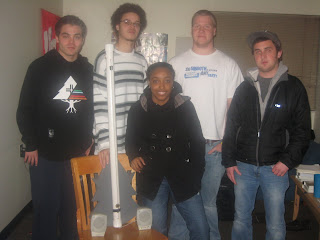Thursday, December 10, 2009
Concert Performance
Today, December 10, was the concert. It was held at 3:00 in Sears Recital Hall. Each group presented their instrument on stage to the audience, then we performed for about 10 minutes. For the limited amount of practice that we had together, it didn't sound too bad. Afterwards, the entire class performed "4 minutes and 33 seconds," which was received oddly by the crowd. Some people looked confused and some giggled. The audience was composed of about 15-20 people.
Tuesday, December 1, 2009
Pictures and Video
Monday, November 30, 2009
Looking Back On It...
While building the guitar, some problems arose.
- The first time the backboard was cut, we made it too small, so it had to be cut again.
- The red wire of the piezo element was accidentally cut off while trying to secure it, so another piezo element had to be bought.
- It was difficult trying to loop the guitar string through the PVC pipe and into the machine tuner.
- Looking back on it, putting frets on the neck of the guitar would have been useful for better playing. Also, notches could have been put on the guitar for a neck strap for easier handling.
In the end, however, everything went pretty smoothly.
String It All Together
In order to install the guitar string to the PVC pipe, first, a wedge was sliced off of a single hole rubber stopper so the stopper would lie flush against the pipe. The string was fed through this hole. The purpose of the stopper was to keep the entire string at a uniform height above the PVC pipe and to make sure the string does not touch the piping at any point, which would distort the sound of the guitar if it did. One end of the string was then fed through the hole in the machine tuning shaft so the string could be tightened or loosened for tuning. Each end of the string was fed into a previously drilled hole on either end of the PVC pipe. The string ran along the rubber foot on the piezo element, so the pickup could "pick up" the vibrations of the string. At this point, the guitar was finished.
Installing the Piezo Element
The piezo element is used on the electric guitar to convert the vibrations from the guitar string into electricity. In order to install the piezo element, or "pickup" as it is also called, the plastic casing on the pickup was cut away, and a rubber foot was attached onto the center of the element. A hole was then drilled in one of the PVC pipe caps, and the plug was cut off of the audio extender cable, which was then fed through the hole in the cap. Next, a cable tie was fed through the non-notched hole out the bottom of the pipe. The cut end of the extender cable was then taped to the cable tie and pulled through the non-notched hole.
Piezo element's 2 wires: ground (black) and signal (red)
Extender cable's 3 wires: ground (bare copper), left and right (both insulated)
The website provided a useful tactic to determine which wires were which. When the extender cable is plugged into a set of speakers, the left speaker makes a buzzing noise when the Left wire is held, and right speaker makes a noise when the Right wire is held. When the ground wire is held, so noise is made. The piezo ground wire was soldered to the extender cable ground wire, and the L and R channels were soldered together to the piezo signal wire.
Piezo element's 2 wires: ground (black) and signal (red)
Extender cable's 3 wires: ground (bare copper), left and right (both insulated)
The website provided a useful tactic to determine which wires were which. When the extender cable is plugged into a set of speakers, the left speaker makes a buzzing noise when the Left wire is held, and right speaker makes a noise when the Right wire is held. When the ground wire is held, so noise is made. The piezo ground wire was soldered to the extender cable ground wire, and the L and R channels were soldered together to the piezo signal wire.
Saturday, November 28, 2009
Attaching the PVC Pipe to the Soundboard
A centerline was drawn down the back of the soundboard, and four evenly-spaced 1/8" pilot holes were drilled along this line. Placing the PVC pipe string side down, the body was clamped on top of the pipe along the centerline with the tuner side of the pipe facing away from the body. Four lag bolts were drilled in the four holes of the body and into the PVC pipe to attach the pipe to the wooden soundboard.
Installing the Tuner Piece
On the side where the string hole was made 3.5" from the end of the pipe, another hole was drilled 90 degrees around the pipe. The shaft of the tuner was put in this hole, and the piece was screwed into place using a wood screw that came with the tuner piece. This tuner piece is used to tighten or loosen the guitar string, adjusting the sound the string makes when it is strummed.
Subscribe to:
Posts (Atom)

